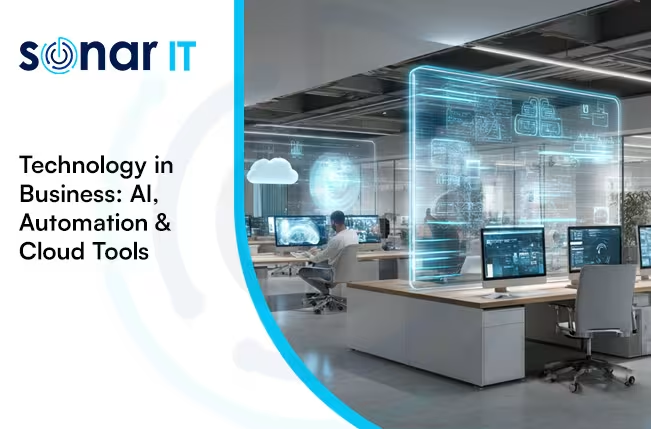Windows 12 is coming… here’s what we know so far
Windows 12 Is Coming: What Your Business Needs to Know
Windows 11 may still feel new, but Microsoft is already deep into planning its next big leap: Windows 12. Expected to launch in late 2024, Windows 12 is shaping up to be more than just a cosmetic upgrade. From subtle UI changes to deeper security enhancements and smarter integrations, it looks like the future of Windows will be faster, more intelligent, and business-ready.
While details are still emerging, one thing is clear: businesses that stay ahead of the curve will benefit most when Windows 12 arrives. Whether you're running Windows 10 or already using Windows 11, now is the time to start thinking about what's next — and how to prepare.
Let’s dive into what we know (and can reasonably expect) so far…
A New Look for Windows: Floating Taskbars and Top-Level Search
One of the most talked-about design changes in Windows 12 is the floating taskbar dock, paired with a top-centre search bar. Unlike the traditional bottom-anchored taskbar that’s been a Windows staple since the 1990s, this new layout shifts the focus to the top of the screen.
What might change:
- Floating Taskbar: Expect the taskbar to appear more like a dock — think macOS-style aesthetics but with the functionality of Windows.
- Top-Centre Search Bar: This prominent search feature may integrate tightly with Windows Search, Bing, and Microsoft 365 tools.
- Widgets & Action Centre Up Top: Rumours suggest that widgets and notifications may move from the bottom to the top of the screen, creating a cleaner and more streamlined interface.
These design tweaks are clearly aimed at improving workflow and discoverability — helping users find information faster and navigate more intuitively. For businesses, that could mean improved user efficiency with fewer clicks.
Smarter Security: Familiar Requirements, But Sharper Focus
Windows 11 was a controversial launch for many due to strict hardware requirements — specifically, TPM 2.0 and newer CPUs. The result? Many older but still functional PCs were left behind.
For Windows 12, we don’t expect Microsoft to raise the bar significantly — but we do expect security to be front and centre.
Key security expectations:
- TPM 2.0 stays mandatory, possibly becoming even more important for features like encryption, biometric login, and secure boot.
- AI-driven threat detection could be more deeply integrated, especially with Microsoft Defender and Smart App Control.
- Zero Trust architecture support may be more tightly embedded into the OS, making it easier for businesses to comply with cybersecurity frameworks.
Put simply, Microsoft is doubling down on protecting data, systems, and users — something that will be welcomed in an era of rising cybercrime.
AI and Automation: A Smarter Windows Experience
As Microsoft leans heavily into AI — through Copilot, ChatGPT integrations, and machine learning across Office 365 — Windows 12 is likely to expand on this.
Early predictions include:
- AI-powered search and system assistance, such as a native Copilot baked into the OS.
- Smarter file recommendations, possibly mirroring features already available in OneDrive and Microsoft 365.
- Background optimisation, where the system can learn user behaviour to prioritise updates, battery use, and app performance more intelligently.
These enhancements could unlock serious productivity gains for businesses that rely on Windows daily.
Hardware Compatibility: Easier Than the Windows 11 Upgrade?
When Windows 11 launched, many businesses faced a frustrating bottleneck: hardware incompatibility. But with Windows 12, that pain point may be less of an issue.
What’s likely:
- Most devices purchased in the last 2–3 years will be eligible for upgrade.
- Microsoft is unlikely to raise requirements beyond what was set for Windows 11 — which means if you're compliant now, you’re likely to be compliant later.
- OEMs (like Dell, HP, Lenovo) are expected to launch Windows 12-ready machines around Q4 2024 or early 2025.
If your current hardware is running Windows 10 or 11 comfortably — especially if it’s been purchased since 2021 — you’re probably in the clear.
What This Means for Your Business
For small and medium-sized businesses (SMBs), the launch of a new Windows OS can feel like a hassle — but it also presents opportunity. Getting your systems ready early can:
- Avoid last-minute upgrade panic
- Improve cybersecurity posture
- Boost performance and productivity
- Future-proof your setup for at least another 3–5 years
Let’s break it down further:
Already on Windows 11?
You’re in a good position. The transition to Windows 12 will likely be smooth, and early adopters may benefit from improved support, faster updates, and better integration with Microsoft 365.
Still on Windows 10?
Now’s the time to consider moving. Windows 10 support officially ends on October 14, 2025. That might sound far off, but between planning, testing, purchasing new hardware, and training staff, time moves fast.
By upgrading sooner, you reduce the risk of software vulnerabilities and improve compatibility with modern tools.
When Is Windows 12 Releasing?
Although Microsoft hasn’t officially confirmed the date, all signs point to a late 2024 release — possibly October or November.
That aligns with the company’s usual release cadence and gives IT teams time to prepare in advance.
Preparing for Windows 12: What to Do Now
If you want to be ready when Windows 12 arrives, here are some actionable steps:
1. Audit Your Current Devices
Check which systems meet Windows 11’s requirements. If they do, they’ll likely be eligible for Windows 12. Replace aging devices that don’t pass.
2. Start Planning a Rollout Strategy
Don’t wait until release day. Get in touch with your IT partner (that’s us) and begin shaping your deployment plan — staged rollouts, testing, staff onboarding, etc.
3. Review Your Software Stack
Make sure the applications your business relies on will work smoothly on Windows 12. Many older apps may need updates.
4. Upskill Your Team
Take advantage of training or workshops to introduce your team to Windows 11 if they’re not using it yet. Familiarity with the current OS will make Windows 12 adoption far easier.
5. Talk to Your IT Support Provider
We can help you prepare your systems, upgrade your infrastructure, and support you every step of the way.
Final Thoughts: Should You Wait or Upgrade Now?
While there’s no need to panic, smart businesses are always planning a few steps ahead. If you’ve been putting off the move to Windows 11, now might be the perfect time — giving your team time to adapt and your IT environment a head start.
Windows 12 will build on the solid foundation of Windows 11. But it’s more than a cosmetic facelift — it’s part of Microsoft’s long-term vision of a secure, intelligent, and integrated ecosystem.
And we’re here to make sure your business is ready for it.
Need help with Windows upgrades or business IT support?
Let’s chat. Whether it’s getting you onto Windows 11 now or preparing for Windows 12 in future, we’ll make the process seamless.
.svg)






